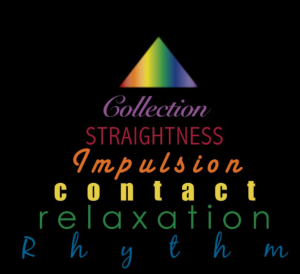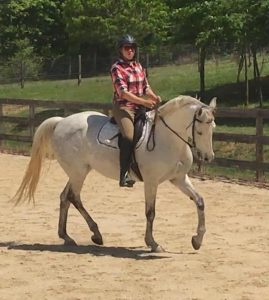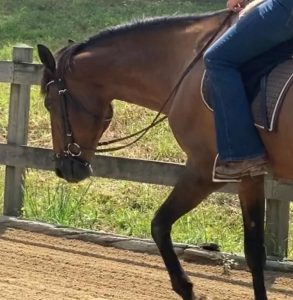 Editor’s Note: Amy Skinner is a regular guest columnist and has been a horse gal since age six. She has presented twice at the Best Horse Practices Summit and is the author of To Catch a Horse: Finding the Heart of your Horsemanship.
Editor’s Note: Amy Skinner is a regular guest columnist and has been a horse gal since age six. She has presented twice at the Best Horse Practices Summit and is the author of To Catch a Horse: Finding the Heart of your Horsemanship.
She rides and teaches dressage and Western. Skinner has studied at the Royal Andalusian School of Equestrian Art in Spain, with Brent Graef, Leslie Desmond, and many others. Visit her website here.
Amy Skinner writes:
In the culture of dressage, many riders think of contact as the first priority. When their ride begins, they pick up the reins and only loosened at the end when riders dismount. “The horse has to learn to accept the contact” is the phrase I hear.
Young horses started in dressage are often and unfortunately lunged with side reins before being ridden to teach them to accept contact before learning how to carry themselves or even how to be steered. Riding on a loose rein, or even loosening to the reins periodically, puts one at risk of being called ‘not a real’ dressage rider.
 Yet the dressage training pyramid begins with rhythm, relaxation, and then connection. The first priority is not contact, but rhythm and relaxation. When a horse has these two qualities, contact is something the horse offers you, not something the horse has to accept.
Yet the dressage training pyramid begins with rhythm, relaxation, and then connection. The first priority is not contact, but rhythm and relaxation. When a horse has these two qualities, contact is something the horse offers you, not something the horse has to accept.
When ridden into relaxation with rhythm, the horse can willingly reach for the bridle and happily connect to the rider’s hand. Considering contact as something the horse must accept is just another way of saying you expect submission. It says: “here is uncomfortable, meaningless pressure that I expect you to deal with without argument.”
Why do riders say this? Riders with this mentality don’t understand the purpose of dressage.
Dressage done well, with classical values, has the purpose of straightening, strengthening and elasticizing the horse. Think of it like physical therapy for the horse’s body. It isn’t exclusive to expensive horses, big movers, calm horses, or riders who can afford $200 breeches and custom boots.
Dressage is the art of making your horse the most comfortable they can be with the goal of longevity. Dressage should improve horses’ soundness and overall quality of life. It should protect the mind of the horse.
 If your priority is submission and a certain head and neck shape, that original purpose of dressage is not possible.
If your priority is submission and a certain head and neck shape, that original purpose of dressage is not possible.
When it comes to teaching students to ride horses into a balanced, willing contact, trail and Western riders are often easier pupils than riders with dressage backgrounds, who have heavy hands and a strict mindset around contact. With the latter, I often must substantiate my dressage experience as the contact method is unfamiliar. It’s hard to teach a mind so closed, and it’s hard for a horse to soften to a hand so hard and fixed.
I want hand and leg aids to be something the horse loves, something they seek. When rhythm and relaxation are put first, they can do this. My seat can feel good to them because their backs are not tense. They will enjoy following where my seat guides them.
 With my hands, I can offer contact as something to reach toward and take when they are ready, just as you can stretch out your hand for someone to take once they trust you. Contact happens on the horse’s time. Contact, done well, has a feel that is pleasant for both parties. It is dynamic and stride for stride, not something you hold in one place. Good contact is like dancing with the horse’s mouth; there is give-and-take, breathing room, and the utmost respect for the mouth of the friend who allows you into their life.
With my hands, I can offer contact as something to reach toward and take when they are ready, just as you can stretch out your hand for someone to take once they trust you. Contact happens on the horse’s time. Contact, done well, has a feel that is pleasant for both parties. It is dynamic and stride for stride, not something you hold in one place. Good contact is like dancing with the horse’s mouth; there is give-and-take, breathing room, and the utmost respect for the mouth of the friend who allows you into their life.
Contact is a gift your horses give you, not something you greedily take from them.